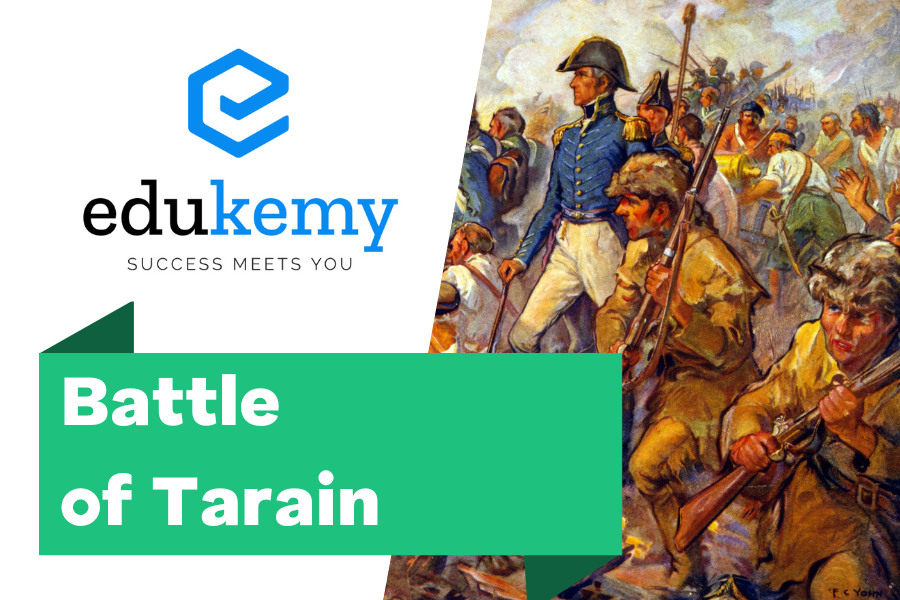
The Battle of Tarain stands as a pivotal moment in medieval Indian history, marked by the clash of military prowess and strategic acumen. Fought in the twelfth century between the Ghurid ruler, Muhammad Ghori, and the Chauhan Rajput king, Prithviraj Chauhan, this confrontation unfolded in the vast plains near the town of Tarain (located in present-day Haryana, India). The battle holds historical significance as it determined the course of power in northern India and left an indelible mark on the subcontinent’s political landscape. The rivalry between the Ghurids and the Chauhans culminated in two distinct engagements at Tarain, with the outcome of the second battle in 1192 shaping the trajectory of subsequent dynastic rule in the region. The Battle of Tarain remains an enduring saga of military strategy, courage, and the complex interplay of political forces during the medieval period in India.
The Battle of Tarain, waged in 1191 and 1192, stands as a pivotal chapter in Indian history, marking the intense struggle between Muizzuddin Muhammad and Prithviraj, two ambitious rulers with their eyes set on supremacy.
Contents
First Battle of Tarain (1191):
The conflict ignited over rival claims for Tabarhinda, culminating in a fierce battle at Tarain in 1191. Ghurid forces suffered a setback, saved only by a young Khalji horseman. Prithviraj captured Tabarhinda, yet surprisingly made little effort to expel Ghurids from Punjab, granting Muizzuddin crucial time for regrouping and plotting a return.
Second Battle of Tarain (1192):
Muizzuddin’s meticulous preparations for the second clash in 1192 heralded a turning point in Indian history. With 1,20,000 men, including heavy cavalry and mounted archers, he faced Prithviraj’s force of 3,00,000. The battle, dominated by cavalry clashes, ended with Prithviraj’s capture and the fall of strategic fortresses. Delhi became a Turkish stronghold, marking the onset of Turkish rule in the region.
Conquest Beyond Tarain:
The aftermath saw Turkish dominance expanding into Bihar and Bengal. Muizzuddin’s return to India in 1194 led to the Battle of Chandawar, a fierce encounter near Kanauj that solidified Turkish control. The expedition to Banaras further secured their foothold, ravaging temples and extending their influence to the borders of Bihar.
Legacy of Tarain:
The battles of Tarain and Chandawar laid the foundations of Turkish rule in North India. Although Muizzuddin lived until 1206, his reign saw the establishment of Turkish control over powerful forts, including Bayana and Gwaliyar, guarding the southern flank of Delhi.
Conclusion
The Battle of Tarain stands as a pivotal moment in Indian medieval history, marked by a series of conflicts that shaped the political landscape of the subcontinent. With the clash between Prithviraj Chauhan and Muhammad Ghori at its center, the battles of Tarain showcased the strategic prowess and military might of both leaders. The outcome of these confrontations had far-reaching consequences, influencing the establishment of Ghurid rule in Northern India. Despite Prithviraj Chauhan’s initial triumph, the subsequent defeats underscored the challenges of maintaining a united front against external invasions. The Battle of Tarain serves as a testament to the dynamic nature of power struggles in medieval India, where shifting alliances and military strategies played a decisive role in shaping the destiny of the region.
Read our ALL MEDIEVAL HISTORY NOTES.
Frequently Asked Questions (FAQs)
Q: What were the First and Second Battles of Tarain?
A: The First Battle of Tarain took place in 1191 between the forces of Prithviraj Chauhan, the ruler of Delhi, and Muhammad of Ghor, a Muslim invader. Prithviraj Chauhan won this battle.
The Second Battle of Tarain occurred in 1192, where Muhammad of Ghor, determined to avenge his earlier defeat, faced Prithviraj Chauhan again. This time, Muhammad of Ghor emerged victorious, marking a turning point in the history of medieval India.
Q: Who were the key figures in the Battle of Tarain?
A: The primary figures in these battles were Prithviraj Chauhan, the ruler of the Chauhan dynasty, and Muhammad of Ghor, a prominent Muslim conqueror. Prithviraj Chauhan led the Rajput forces, while Muhammad of Ghor commanded the Ghurid army.
Q: What were the outcomes of the Battles of Tarain?
A: The First Battle of Tarain resulted in victory for Prithviraj Chauhan, consolidating his rule in northern India. However, the Second Battle of Tarain proved to be a significant setback for the Rajputs, as Prithviraj Chauhan was defeated, leading to the establishment of Muslim rule in northern India.
Q: How did the Battles of Tarain impact Indian history?
A: The Battles of Tarain had a profound impact on Indian history as they marked the beginning of the Muslim rule in northern India. Muhammad of Ghor’s victory paved the way for subsequent Muslim rulers and dynasties, such as the Delhi Sultanate, to establish their dominance in the region.
Q: What military strategies were employed in the Battles of Tarain?
A: The battles involved traditional Rajput warfare tactics, such as the use of cavalry and archery, on the part of Prithviraj Chauhan. On the other hand, Muhammad of Ghor implemented strategic changes, including the use of a disciplined and well-organized cavalry, which played a crucial role in his success during the Second Battle of Tarain.
In case you still have your doubts, contact us on 9811333901.
For UPSC Prelims Resources, Click here
For Daily Updates and Study Material:
Join our Telegram Channel – Edukemy for IAS
- 1. Learn through Videos – here
- 2. Be Exam Ready by Practicing Daily MCQs – here
- 3. Daily Newsletter – Get all your Current Affairs Covered – here
- 4. Mains Answer Writing Practice – here

